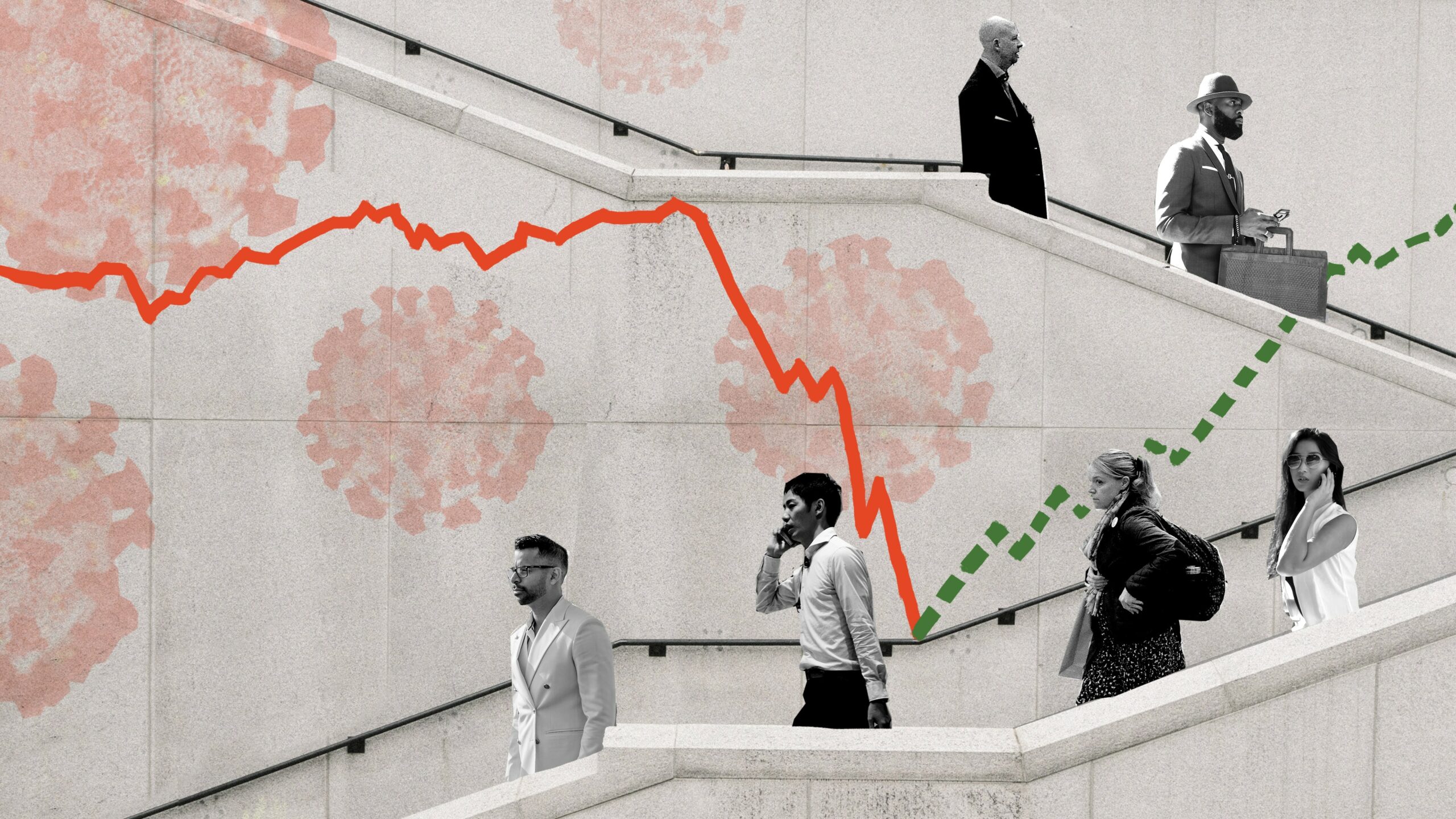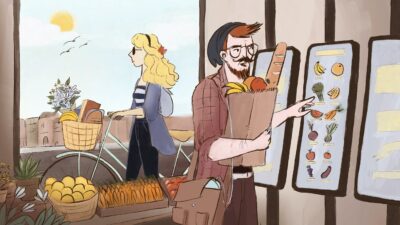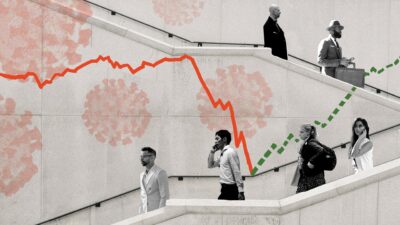Sandra Peter and Kai Riemer

The fashion industry on Corona Business Insights
The fashion industry: the standstill, a window of opportunity and the future of the industry in the wake of the pandemic.
As COVID-19 sets out to change the world forever, join Sandra Peter and Kai Riemer as they think about what’s to come in the future of business.
Shownotes
What is happening in the fashion industry during the pandemic
What is next for the fashion industry after the pandemic
Open letter to the fashion industry
Why the fashion industry faces an ‘existential crisis’
This iteration of London Fashion Week was digital
Zara owner to close up to 1,200 fashion stores around the world
This episode is part of a podcast series covering what COVID-19 will mean for the business world, where we look at the impact on the economy, businesses, industries, workers and society. This is part of our ongoing coverage of the impact of COVID-19 on the future of business.
Follow the show on Apple Podcasts, Spotify, Overcast, Google Podcasts, Pocket Casts or wherever you get your podcasts. You can follow Sydney Business Insights on Flipboard, LinkedIn, Twitter and WeChat to keep updated with our latest insights.
Send us your news ideas to sbi@sydney.edu.au.
Dr Sandra Peter is the Director of Sydney Executive Plus and Associate Professor at the University of Sydney Business School. Her research and practice focuses on engaging with the future in productive ways, and the impact of emerging technologies on business and society.
Kai Riemer is Professor of Information Technology and Organisation, and Director of Sydney Executive Plus at the University of Sydney Business School. Kai's research interest is in Disruptive Technologies, Enterprise Social Media, Virtual Work, Collaborative Technologies and the Philosophy of Technology.
Share
We believe in open and honest access to knowledge.
We use a Creative Commons Attribution NoDerivatives licence for our articles and podcasts, so you can republish them for free, online or in print.
Transcript
This transcript is the product of an artificial intelligence - human collaboration. Any mistakes are the human's fault. (Just saying. Accurately yours, AI)
Intro From the University of Sydney Business School. This Sydney Business Insights.
Sandra And this is Corona Business Insights. I'm Sandra Peter.
Kai And I'm Kai Riemer.
Sandra And with everything that's happening out there, it's difficult to understand what COVID-19 will mean for the business world. So in this series, we've been unpacking its impact on business, economy, industry, government workers, and society, and looking at the effects of the pandemic.
Kai And this podcast is part of a larger initiative by the University of Sydney Business School. Our COVID business Impact dashboard is a living initiative which we constantly update with insights and resources from academics, from industry experts, from Nobel Prize winners, movers and shakers.
Sandra And you can find all of these resources online at sbi.sydney.edu.au/coronavirus.
Kai And today we talk about the impact of the COVID-19 pandemic on the fashion industry.
Sandra The fashion industry and most fashion businesses have been impacted quite strongly by COVID-19, as they're experiencing both a shock on the demand side and also on the supply side. This is, of course, brought on by all the measures that are designed to limit the spread of the disease, as well as the actual impact of the disease. Many of the factories and production lines have ground to a halt.
Kai People have stopped spending on fashion or changed what they spend money on. As people are sheltering in place, they don't go out to physical retail stores. They also don't go out to restaurants, bars, clubs. So the kind of fashion that people need has changed. So there's a bit of an uptick in casual wear, activewear, loungewear, but large parts of the fashion industry have done it really tough. And that goes from retail workers at the front end to all the way back to workers in developing countries who are employed to actually produce a fashion and anything in between.
Sandra And let's not forget, this is a very large industry. It is generating about two and a half trillion dollars a year in the global revenues, that is numbers from before the pandemic hit. And at the height of the pandemic, so in the period from March till May, sales slumped by almost 75 percent year-on-year, according to various studies, including one from the Boston Consulting Group.
Kai And in various studies, the impact for the entire year reached from about 30 per cent contraction in global revenue to more optimistic ones that hover around 12 per cent for Australia. But it is worse for those retailers and fashion labels who are not able to sell directly to customers online, were hit much worse by the pandemic. And that obviously then raises questions about who is going to survive this downturn. The Australian Fashion Council has done a survey among the 182 companies that it represents. And the picture is pretty bleak. There's only 34 per cent who say that they are confident that they will absolutely bounce back. 43 percent are not confident that they will fully recover financially. And almost a quarter say that they will not recover at all. So we're looking at a fairly dramatic shakeout in an industry that is employing a lot of people globally.
Sandra And of course, this is just the beginning. Whilst we've seen a lot of companies file for bankruptcy or go into administration in the US department stores like JCPenney and Neiman Marcus, also in the UK, Debenhams, Cath Kidston, have all gone into administration, but Zara is set to close up to 12 hundred fashion stores around the world over the next year.
Kai And that is just the visible part of what we can see. There's obviously fall out among workers in countries like Bangladesh that are also doing it really tough with the pandemic at the moment, where a lot of employment is dependent on how well the global fashion industry does.
Sandra And of course, many companies have cancelled their orders, given that stores are closed and sales are down, and this has left factories and workers in countries like India and Bangladesh and Vietnam facing a crisis not just because of the pandemic, but because of reduced demand in Western countries.
Kai And the shutdown of global supply chains means that there's now a lot of excess stock within those supply chains that might never see the light of day, that might never be sold in retail stores. But many have said in the industry that this points to a larger problem, to a systemic issue, to a problem in the industry of overproduction and wastefulness, for which this pandemic might actually provide a moment of reckoning.
Sandra And indeed, over the last couple of weeks, there have been three very public calls by groups of designers and brands and fashion businesses that have put forward manifestos for change for the industry. They've come from retailers like Saks Fifth Avenue, but also from groups of designers, for instance, organised by fashion designers like Dries Van Noten, but also from fashion publications like the Business of Fashion, who have all asked for the industry to consider a systemic change, in particular around sustainability around the waist and around fair wages.
Kai And before we go to some of the solutions, it's worth looking at what are some of those systemic problems. And some of them we have actually covered on The Future, This Week podcast, and we will put the episode in the shownotes, which centre around the impact of what is called 'fast fashion'. Fast fashion, the production of fashion at a rapid rate, the fast consumption, but also the discarding of fashion items at a rapid pace, where a staggering number of items bought are only worn once or are never worn, and go straight to second hand if lucky, or into landfill. To the extent that estimates say that there's about 30 to 40 percent of overproduction systemically within those supply chains of items produced that will never be sold. The fashion industry is second in the world for water pollution and contributes 10 percent of all carbon emissions. So the industry at large has a huge impact on the environment and therefore calls to make the industry more sustainable, both financially by reducing waste, but also environmentally.
Sandra So the idea here would be to build on the foundation of what has emerged over the last few years as the slow fashion movements that focuses on the quality of garments, not on how quickly you can get them to the market or in the hands of the consumer, at producing longer lasting pieces that focus on the quality of the piece and the craft that went into it. And providing solutions, a bit like Patagonia has had in the past, providing solutions for repairing, reusing, recycling, upcycling garments and giving them multiple lives and only replacing them when it's absolutely necessary.
Kai And there's also hope, of course, that developments amongst consumers towards more sustainable consumption, that we already saw before the pandemic, will accelerate, that the pandemic might be a moment where people come to rethink their values. But that's only part of the story. The other part of the story is a systemic problem in the fashion industry itself, which is known as the fashion calendar. The way in which items are often released out of season, where during summer the fall collection is in stores, while the actual summer items during summer are already heavily discounted, to the detriment of the industry. There's been voices wanting to change this for quite a while. And so there is a hope now, as global supply chains are disrupted, as things come to a slow-down during the pandemic, that this might finally be the moment where industry could come together and collaboratively change the way in which fashion is designed, presented at fashion weeks, and then makes its way into stores, and then is finally consumed.
Sandra So let's have a quick look at what have been some solutions. First, in the short-term, what is happening right now to keep the industry going, but also what could be some responses to this systemic change, which indeed would take much longer to trickle through the industry.
Kai So in the short-term, while the pandemic is still going on, the industry does what most industry do, they are looking for a digital solution, they're looking to online solutions. So many fashion weeks and shows were cancelled, instead we had online formats for the presentation and wholesale of fashion. And of course, retailers are moving more and more to innovative formats for selling their fashion online directly to consumers.
Sandra And a good example of that was the London Fashion Week this month, which was fully online. It lived on the website, looking a bit like Netflix. And it was a combination of video and art and music playlists and photography and designer Q and A's. But it ended up feeling a bit more like a magazine or like an Instagram feed, rather than what Fashion Week has traditionally been.
Kai And of course, it became painfully clear that this can only replicate a tiny part of what makes Fashion Week, Fashion Week. All the networking, all the in-person backroom negotiations that go on, all the buzz that the Fashion Week generates, the jobs that hang on the Fashion Week, the consumption, retail, hospitality, all of this obviously falls away when, you know, you replace this basically with a website.
Sandra And of course, there have been other short-term solutions that people have tried to come up with. Anna Wintour repurposed the Vogue Fashion Fund to support all members of the fashion supply chain, rather than going to potential star designers, being more inclusive and understanding that this industry actually employs a lot of staff, many of whom are casual staff or part time workers who are behind the scenes, people like pattern makers and manufacturers and seamstresses, all of whom have been impacted by the pandemic, but less visibly so than the fashion brands themselves.
Kai But let's look at some of the long-term proposals that are being made. So, some in the industry say that this presents a long-awaited opportunity to make more sweeping structural changes and that if the industry is not able to make those changes now, it will probably never be able to do so. And so one of those would be to change the way fashion is produced that is less wasteful, that produces less stock that gets stuck in the supply chain, that ends up in warehouses, that ends up never being sold at full price or never being sold at all. So that goes to the 30 to 40 percent waste in the supply chain. And a solution here is what's called on-demand production. So rather than producing large quantities of stock based on prediction and forecasts that are then flooded through the supply chain, that end up in warehouses never being sold, that goes to the 30 to 40 percent waste that we mentioned. So an on-demand solution would try to produce only those items that are actually being sold, either wholesale where retailers order and then labels would produce what the retailers actually want, to reduce the back end warehousing of items, or, at the consumer end, where the customer will receive to their doorstep an on-demand produced garment, in a very short turnaround time.
Sandra That's would, of course, also move production locally so there would be less air travel, less waste, less greenhouse emissions, and would look at new ways of manufacturing so that it's economically viable to produce small quantities of garments. But that, of course, raises some interesting questions around where the jobs will be in fashion in the future, and how many of those jobs will there be? Because let's not forget, the fashion industry employs a lot of people. In the US alone, for instance, the fashion industry is linked to 53 million jobs.
Kai And in the UK, it's said that one sixth of all jobs are either directly in the fashion industry or closely linked to the fashion industry, which obviously is a lot of employment.
Sandra And here is where one of the paradoxical effects of this shift in the industry would come, where with producing clothing more sustainably and reducing the waste, which, as you mentioned, can be up to 40 percent of what is being produced, would also lead to very significant job losses, especially in certain parts of the world, in places like Bangladesh, because of that reduction in waste.
Kai And it's a double effect, because you're reducing the waste in the supply chain, but you also increase the degree of automation as you move to on-demand production. A lot of the cutting of fabric might be done more by machines than it is already being done. So there could be a significant effect on jobs globally. But we also need to point out that on-demand production is only applicable to certain parts of the industry. It will never be a model for the entire fashion industry. And here is where the second big proposal for change comes in, one that is much harder to achieve. On-demand production can be taken up by single producers, by certain labels, by retailers individually. But changing the fashion calendar, changing the way in which seasons operate needs to be done at the entire industry level, needs to be done collaboratively, because it works very much on the collective expectations of consumers, what retailers stock at certain given moments in time when fashion shows are being held. And so these structural changes are obviously much harder to achieve than individual moves to different forms of production.
Sandra And whilst this might be a moment, as has been pointed out by leaders in the industry, to have a hard rethink of what the values of the industry are and what the industry stands for, it remains to be seen whether the next six months will indeed bring structural change to the industry or whether a rapid recovery, especially in markets like China and Europe, will lead to the industry just going back to how business was always done.
Kai So the question being, is this a case of never waste a good crisis, or one of panic and neglect where we're painfully aware of the problems now, but once the crisis subside and everything opens back up, we're back to the old ways of doing business.
Sandra And that's where we want to leave it. This has been Corona Business Insights. Until next time.
Kai Thanks for listening.
Sandra Thanks for listening.
Outro From the University of Sydney Business School, this is Sydney Business Insights, the podcast that explores the future of business.
Close transcript














